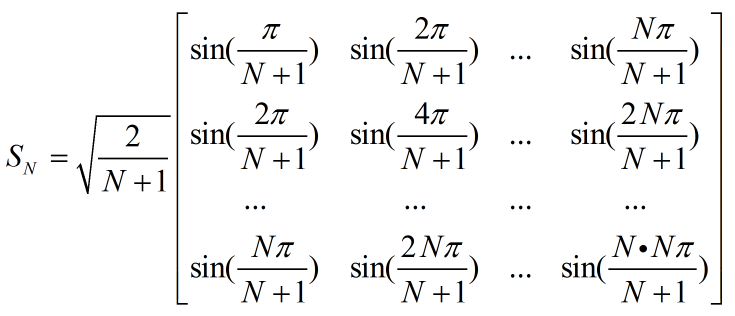离散正弦变换(Discrete SineTransform, DST):
类似于DCT,离散正弦变换也有八种形式,常用的是DST-Ⅰ,一般我们提到DST而不特殊说明即指DST-Ⅰ。
这里直接给出DST-Ⅰ的定义:
正变换:
逆变换:
因此可得到变换矩阵SN:
变换矩阵SN是一个正交矩阵,而且它还是一个对称矩阵(转置与本身相等),所以正变换与反变换是相同的。
基于OpenCV离散正弦变换:
void MainWindow::on_pushButton_10_clicked()
{
Mat img = imread("D:/Pic/2.jpg",0);
Mat src(img.rows,img.cols,CV_64FC1);
img.convertTo(src,CV_64FC1);
Mat dst(src.rows,src.cols,CV_64FC1);
double pi = 3.141592657;
Mat tmp(200,200,CV_64FC1);
int N = 200;
for(int i=0;i<200;i++)
for(int j=0;j<200;j++)
{
tmp.at<double>(j,i) = (double)(sin(pi*i*j/(N+1))*pow(2/(N+1),1/2));
}
dst = tmp*src*tmp/45000;
imshow("dst",dst);
Plot* plot = new Plot(dst);
//QGridLayout *grid = new QGridLayout(ui->frame);
//grid->addWidget(plot,0,0);
//plot->setTitle("3D");
plot->coordinates()->axes[X1].setLabelString("X(um)"); //只能写在这
plot->coordinates()->axes[Y1].setLabelString("Y(um)"); //设置坐标轴标签
plot->coordinates()->axes[Z1].setLabelString("Z(nm)");
plot->coordinates()->axes[Z2].setLabelString("Z(nm)");
plot->coordinates()->axes[Z3].setLabelString("Z(nm)");
plot->coordinates()->axes[Z4].setLabelString("Z(nm)");
double start,stop; //设置颜色条
plot->coordinates()->axes[Z1].limits(start,stop);
plot->legend()->setLimits(start,stop);
// plot->legend()->setAutoScale(true);
plot->resize(700,600);
plot->show();
//grid->~QGridLayout();
}效果图:




























 426
426

 被折叠的 条评论
为什么被折叠?
被折叠的 条评论
为什么被折叠?








